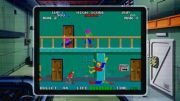

Namco Museum Switch
A package containing ten classic arcade games from the 1980s, which were developed by the titular company.
Namco Museum Release Date Switch
28July2017
developer: Bandai Namco Entertainment publisher: Bandai Namco Entertainment Official website
 game language: English
game language: English
Games similar to Namco Museum
SNK 40th Anniversary Collection
Namco Museum for SWITCH is a package containing ten classics, which had their peak of popularity in arcade game rooms. The compilation was created by Bandai Namco and all the games included were developed by Namco in the 1980s – the Japanese developer was one of the first major game producers. Some of its games, such as Pac-Man or Galaga, became iconic parts of pop-culture, gaining recognition all over the world. It is worth noticing, that the Namco Museum series exists on the market since the beginning of the 2000s. Over the course of several years, the franchise has encompassed various compilations of Namco's greatest hits – different installments of the series have been released for all the major gaming systems.
Mechanics
To begin with, the player selects one of ten available games. Importantly, nearly all of these games have their own online leaderboards. Thanks to this, the player can easily compare their results with scores of the others from all over the globe.
Pac-Man (1980) was one of the most popular games in the world. The compilation offers the original version of the game, which was introduced in arcade rooms at the beginning of the 1980s.
Dig Dug (1982) is a two-dimensional arcade game featuring elements of logic. The player takes on the role of a miner whose job is to eliminate creatures inhabiting underground caverns.
Galaga (1981) is one of the first space shoot'em ups, which played a crucial role in the birth of the genre. The player controls a fighter ship, which moves in two directions only, at the bottom of the screen. One's task here is to neutralize enemies.
Galaga '88 (1987) – a sequel to the original Galaga, offering significantly better audiovisuals and bringing minor changes to the gameplay formula. Even bigger challenges are placed in front of the player here.
The Tower of Druaga (1984) – 2D arcade game with elements of role-playing; it was inspired by myths and the culture of the ancient Sumeria. The player takes on the role of the legendary Gilgamesh. The hero tries to find and kill a demon by the name of Druaga, who has remained in concealment, at the top of a sixty-floor tower.
Rolling Thunder (1986) – 2D arcade shooter, which casts the player in the role of Albatross - a member of an international police organization known as WCPO. In New York, the protagonist searches for traces of a missing agent that most likely had been kidnapped by a criminal group named Geldra. During the adventure, the player uses a basic pistol and machine weapons to eliminate gangsters that cooperate with Geldra.
Rolling Thunder 2 (1990) – a direct sequel to Rolling Thunder. The organization known as Geldra returns, performing a terrorist attack, which causes the destruction of a network made up of terrestrial satellites. Agent Albatross enters the stage again to fight the threat. Because a new mode for two players was included, Albatross can be accompanied by agent Leila.
Sky Kid (1985) – a two-dimensional shooter game, which places the player in control of small biplanes from the World-War I period. The player completes a series of missions requiring them to drop bombs on enemy positions and to shoot down designated targets.
Splatterhouse (1988) – a 2D beat'em up inspired by classic horrors from 1980s, such as Friday the Thirteenth or The Evil Dead. The player assumes the role of Rick - a student of parapsychology, who gets trapped inside an old, American estate. Thanks to a mysterious power of the mask of terror, he gains superhuman strength and endurance, which helps him in the fight against monsters haunting the old house.
Tank Force (1991) is a two-dimensional arcade shooter, which places the player in control over tanks. The game offers seven military vehicle models, as well as fifteen kinds of power-ups.
Technical aspects
The audiovisuals of particular games included in this compilation have not changed significantly since the original releases from the past. Neither did the creators include any extended graphical settings, such as screen filters. However, the player can change difficulty settings, the number of available lives, as well as other details concerning gameplay itself.
Last updated on 18 July 2017
Game mode: single / multiplayer Multiplayer mode:
PEGI rating Namco Museum






